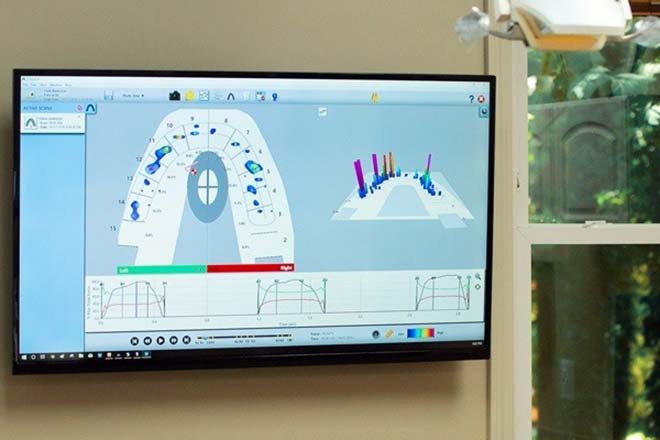TMJ Therapy
at Georgia Dental Medicine
The TMJ, temporomandibular joints, or jaw joints are the hinged joints on either side of the mouth that connect the lower jaw (mandible) to the upper jaw (maxilla). If you place your fingers on the jaw just in front of your ears and open and close your mouth, you can feel the TMJ at work. While there are two temporomandibular joints, they work in unison and are typically referred to collectively as the TMJ.
TMJ Disorders
To create jaw movement, the TMJ are comprised of small, interworking bones, ligaments, tendons, synovial fluid and cartilage. If you think about how many times per day you open and close your mouth to speak, eat or yawn, you will certainly understand why they are considered the hardest working joints in the body.
When the tissues within the TMJ become inflamed, or joint movement is compromised by stress, strain or overload due to poor bite balance or trauma from teeth grinding and clenching, this can trigger a number of pain symptoms in the jaw and facial muscles. As a group, TMJ disorders are generally classified as ‘Temporomandibular Joint Dysfunction’ or TMD.
Health Problems and TMD
The TMJ is known as the “great imposter”. TMD can be the underlying cause of a number of health conditions, or, TMJ symptoms can actually be related to major illnesses. Health conditions commonly connected to TMD/TMJ include:
- OMD (Occluso-Muscular Disharmony)
- Physical damage to the disc or ligament of the joint
- Osteoarthritis
- Migraine Headaches
- Avascular Necrosis
- Progressive Condylar Resorption
- Arthritis
- Osteochondritis Dissecans
- Infection
- Lyme Disease (TMJ pain may in fact be a symptom of Lyme Disease)
- Oral Cancer or Cancer of the Jaw (disguised as TMJ pain or symptoms)
- Ganglion or Synovial Cysts
OMD (Occluso-Muscular Disharmony)
OMD (Occluso-Muscular Disharmony) is a condition in which the teeth, muscles, joint and central nervous system are ‘out of sync’.
The mouth is a machine: if one portion of the machine is not functioning correctly, the rest of the machine suffers. In the case of the mouth, this can mean sore muscles, tiredness, headaches, sore teeth, worn, broken and loose teeth, painful joint(s), noisy joints (popping or clicking), ear aches and other issues.
This ‘machine’ of ours is comprised of teeth, muscles, bone, joint, ligaments and a brain that controls it all. A change in any one area will affect the others. The easiest part of this machine to change is the teeth. By affecting a change to the teeth, we can affect the other parts of the system and improve the mouth's function.
What therapies are available for OMD and TMD?
The most common treatment for OMD and TMD is bite splint therapy. A bite splint can be diagnostic and therapeutic at the same time; by using a specially designed plastic bite splint to have the teeth and joints rest in the ideal position, the jaw muscles and joints relax.
Often, the teeth are the main reason the joint is unable to seat properly, when this happens, the jaw muscles have to brace and work harder to stabilize the joint. By relieving this tension on the joints, Dr. Anderson can test the teeth, muscles and nerve response to identify the problems within the system.
Bite splints require extreme precision and skill to tune to create a positive change in a patient's musculature and joints. Splint therapy can take multiple visits over many months.
Disclusion Time Reduction Therapy (DTR)
Another method of TMD treatment is DTR or disclusion time reduction therapy.
Every tooth in the mouth is connected to the bone via a periodontal ligament (PDL). The PDLs relay sensory information to the brain that then sends signals to the muscles. If teeth hit at the wrong time, then muscles get information telling them to become hyperactive. In contrast, if the correct teeth hit at the right time, the muscles get signaled to relax.
Hyperactive muscles can become painful. You know that burning, sore sensation in your muscles after working out? That is caused by lactic acid. This same process can occur in our chewing muscles.
Using diagnostic technologies that measure the bite and muscle-nerve response, Dr. Anderson can develop a plan to make micro-adjustments in how the teeth come together to help the muscles relax.

TMD and TMJ Technology at Georgia Dental Medicine
Digital technologies that Marietta TMJ dentist Dr. Chris Anderson uses in TMJ/TMD assessment, diagnosis and treatment include:
EMG (Electromyogram)
EMG is used to measure electrical activity in muscles as they are tightened and contracted. This helps Dr. Anderson analyze muscle movement to identify the position(s) that cause them to become hyperactive.
JVA (Joint Vibration Analysis)
JVA gives Dr. Anderson the opportunity to listen to a computerized audio representation of joint movement to detect friction or vibrations that indicate changes in the joint.
T-Scan
T-Scan is a digital bite analysis system that Dr. Anderson uses to measure bite pressure and help locate interference points that may be related to TMD/OMD symptoms.
Referral and TMJ Consultation at Georgia Dental Medicine
If your physician has recommended that you see a dentist for evaluation of the TMJ due to chronic jaw pain, facial pain, migraines or persistent headaches, please Contact Our Georgia Medicine Team to schedule a consultation with Dr. Chris Anderson.
Our doctor referral form provides Dr. Anderson will valuable information to assist him with your diagnosis and care. Please take a moment to download/print our referral form and bring it with you to your consultation appointment.
Georgia Dental Medicine Referral Form .pdf
Due to the time and complexity of TMJ appointment this office requires a $250.00 NON REFUNDABLE DEPOSIT for all initial TMJ appointments. The deposit is taken at booking of the appointment.